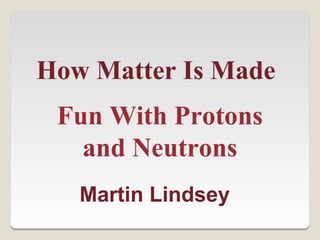
Martin Lindsey MSIMatter Presentation
- 1. How Matter Is Made Fun With Protons and Neutrons Martin Lindsey
- 2. Matter that we can see, touch and smell is composed of molecules. Molecules are composed of atoms which are made of protons, neutrons and electrons. So what are protons and neutrons made of?
- 3. Neutrons and protons are both made up of smaller particles known as quarks. NEUTRON NEUTRON The neutron consists of two down quarks with charge − ⁄ 3e, 1 and one up quark with charge + ⁄ 3e. The decay of one of the 2 down quarks into a lighter up quark can be achieved by the emission of a W boson. This involves the “weak interaction”, a short range force which acts on electrons, neutrinos and quarks. It is governed or mediated by the W and Z bosons.
- 4. NEUTRON NEUTRON This is called beta decay. By this means the neutron decays into a proton(which contains one down and two up quarks), an electron, and an electron neutrino. Under the Standard Model of particle physics, because the neutron consists of three quarks, the only possible decay mode without a change of baryon number is for one of the quarks to change flavor via the weak interaction.
- 5. However, protons are known to transform into neutrons through the process of electron capture (also called inverse beta decay). For free protons, this process does not occur spontaneously but only PROTON PROTON when energy is supplied. The equation is: p+ + e- → n + ν e Remember from the neutron example that the process is reversible; neutrons can convert back to protons through beta decay, a common form of radioactive decay. This occurs when the proton and neutron are part of a larger nucleus.
- 6. The “strong interaction” is the force through which quarks PROTON PROTON interact to form neutrons and protons. It also holds neutrons and protons together to form nuclei. The gluon mediates the strong interaction.
